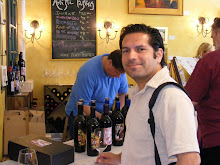
When Cortes and the conquistadors arrived in Tenochtitlan on november 8,1519, the capital of the Aztec Empire, he and his men marveled and later chronicled the city's grandeur and bustling marketplace. Those Spanish soldiers that were old enough to have seen Constantinople at its heighth claimed it to be no where near the spectacle of Tenochtitlan.
Today, that spirit remains, and the wares and foods of the Zocalo, near the Templo Mayor,the ruins of the Aztec empire,are of prehispanic origin. You will not find bacon-wrapped hot dogs here, nor tortas.
Here, the traces of the fallen empire sit next to the Zocalo, town square, the second largest town square in the world, as a reminder of Mexico indigenous past.

The remains of the Templo Mayor(Grand temple)will stir your soul, and I think every Mexican citizen, or Mexican living abroad should visit this sacred ground once in their life.The ancient rythyms of Tenochtitlan(capital of the Aztec Empire), the smell of sage,the incantations of white clothed charmers, and the proud cries of artisinal food vendors using musical pitches to cut through the crowd bring this part of the city to life.

Here, a shaman, or holy man, gives guidance and cures that have existed for thousands of years. And, right next to Mexico City's largest cathedral, a resistance to conversion that has been in place for almost five thousand years.

While I've seen tribal dancers in other parts of Mexico, here it takes on a more profound gesture.

You will also see tamale vendors hawking their steamed packages in a sing-song spanish with a nahuatl(a native language of the Aztec empire)accent."Ta-ma-LAYS,ta-maLAYS."
The other popular food here is a bit more mysterious. Vendors have baskets of thin, crispy,oval shaped, blue corn tortillas, and a few containers of toppings.
This has been a more difficult than usual report. It took me over seven months, and three visits to Mexico City to figure out what exactly this antojito(little whim) was, and where it came from. At first glance, it looks like a huarache, which it is.A huarache is an antojito made from corn masa shaped like a huarache sandal and topped with various foods. Asking about ten different vendors on three separate trips, I got mixed answers. It's a dorada(crispy tortilla), a tortilla de maiz, a tostada....I tried asking people eating them and they had NO clue whatsoever. "To tell you the truth, I don't know", said one young man with a mouth full of huarache and cactus.
I couldn't find much on these on english language sights and the searches using the wrong name for this snack of course were futile. I've only passed through Toluca, the capital of the state of Mexico. These huaraches come from Toluca and are distinct from Mexico City style huaraches,Oaxacan, and Pueblan huaraches found throughout the Districto Federal.
Even the chilangos(people from DF), and Mexican tourists haven't a clue. I suspect some vendors just buy the tortillas made in Toluca, about an hour away from the capital, and make the toppings to cash in on the popularity of these huaraches.They aren't necessarily trying to share Tolucan gastronomy;they're out to make a buck. Some stated the huaraches were Tolucan, but none properly named their one and only product as a huarache.

The preparation is fast and simple, an almost amusement park like expediency, like grabbing some nachos at Disneyland, or cotton candy from the fair.
The vendor draws a brittle,oblong, blue corn tortilla, spreads the refried beans, covers the huarache with cooked nopales(cactus), cilantro and onions,an ample sprinkling of cotija cheese, and a salsa roja. Delicious, healthy, and fast, these street bites are delivered from a couple of baskets and shopping bags lined with plastic.This set-up makes even the smallest stand look cumbersome.

These have been around since 1920, first registered by Senora Apolonia Jaimes Romero, the recipe unchanged until the '60's, when the cheese and beans were added to the recipe.The city of Toluca recently celebrated this dish by making the largest huarache in the world. Soon, it will be the first antojito in the Guiness Book of World's Records.
Toluca, which was known as Tollocan in the Pre-Columbian period was conquered by the Mexica, the tribe that ruled the Aztec empire, in 1478, is the capital of the state of Mexico, and home to a rich gastronomy.
Join the other Mexican tourists at the Templo Mayor for some healing, and a huarache toluqueno. It's a modern day tribute to the rulers of the valley of Mexico, and an unforgettable taste of Toluca.
Huaraches toluquenos
Various vendors
near the Templo Mayor just across from
the northeast corner of the Zocalo, on
the east side of the cathedral.
Daytime only.








2 comments:
I love these as well. They sell the shells in roaming Tianguis markets too and remember buying some to eat at my uncles house.
When I went the vendors and customers all just called them clayudas though, ha ha.
Anyhow, nice homage report man.
Glutster-I heard them called huaraches, too. Amazing, almost like getting directions in Mexico, you have to ask 10 people to find a place right in that neighborhood.
Post a Comment